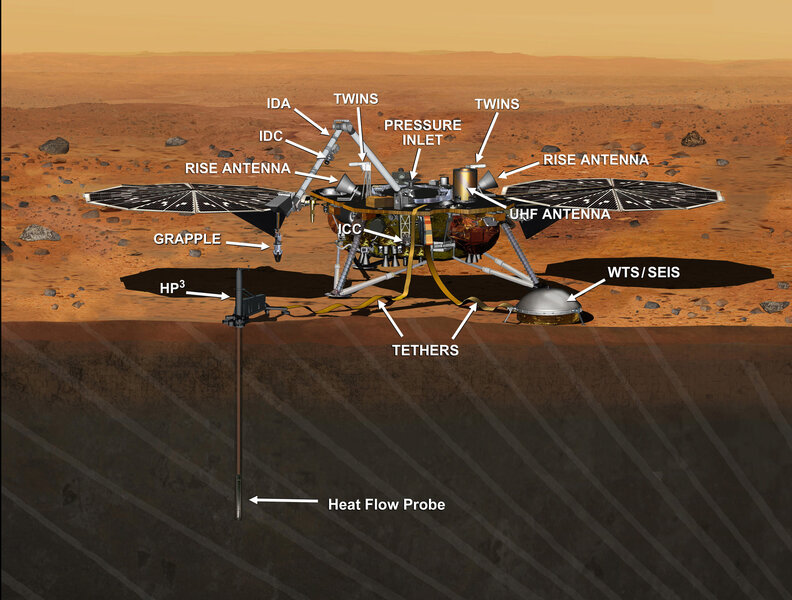Create a free profile to get unlimited access to exclusive videos, sweepstakes, and more!
NASA hopes to launch its next big Mars lander, InSight, tomorrow!
NASA is ready to launch its next big mission to the Red Planet: Mars InSight!
First, about the launch. It's scheduled for tomorrow, Saturday, May 5, 2018, at 11:05 UTC. That’s 04:05 Pacific time, yes, a.m., so if you want to see it you'll have to be up early. In an unusual move, the launch will be from Vandenberg Air Force Base in California. Normally, interplanetary missions are launched from Florida, but due to some peculiar circumstances the site was moved to California. It takes more power to launch to Mars from California, but happily the rocket, an Atlas V, has that to spare.
This will be the first interplanetary mission ever launched from Vandenberg. If you live in the Southern California area, NASA has info on how to watch the launch with your own eyeballs. If you don't live near there, never fear: It'll be live-streamed.
You should be aware that the weather as of now isn't looking great for launch; early fog reduces visibility. However, the launch window extends to June 8, with an opportunity every day (though the time of day varies a bit). Hopefully they can get this candle lit earlier rather than later.
Once launched, InSight will travel for about six months to get to Mars, and is scheduled to set down on the surface on November 26, assuming it launches tomorrow. It's a lander — the first NASA mission to Mars since MAVEN, and the first planned to touch down since Curiosity — and will be looking into marquakes.
Yes, you read that right. InSight stands for Interior Exploration using Seismic Investigations, Geodesy and Heat Transport. It has very sensitive seismometers on it (called SEIS, for Seismic Experiment for Interior Structure), designed to investigate seismic activity on Mars. This is critical to understand the planet's interior. In fact, it's how we've learned so much about our own planet's innards! As waves travel through the interior, they move through different material and can be changed (for example, some kinds of waves can't travel through liquids, which is how we found out part of Earth's core is molten iron), revealing Mars' structure. It'll also detect meteorite impacts! That's pretty nifty.
One of the scientists on the team that built the seismometers wrote an article about them that's fun to read; he talks about some issues they had just a few weeks ago that threatened the launch! It was resolved, but what was causing it is why the article is cool. Go check it out.
InSight is also equipped with a heat probe (Heat Flow and Physical Properties Probe, or HP3) that will penetrate the surface to see how heat flows up from the interior. This is an ambitious experiment; the probe is supposed to hammer itself an amazing 5 meters down into the Martian surface, far more than has even been attempted or achieved before.
Very interestingly to me, a set of radio antennae (Rotation and Interior Structure Experiment, or RISE) will measure the planet’s wobble. Have you ever watched a top spinning on a flat surface? The axis of rotation of the top will make a circle in a process called precession. This is due to friction with the table applying an off-center force (called torque) to the top. Other forces can cause the precession itself to wobble as well, and this is called nutation.
How a spinning object precesses and nutates depends on the forces acting on it, and the structure of the object. The forces in this case are mostly from the gravity of the Sun and Jupiter. As Mars wobbles, the rotation rate is affected very, very slightly. This can be measured with extreme accuracy, though, by sending radio signals to Mars and having them reflected back using radio antennae. Doing this with previous missions like Viking and Pathfinder revealed that Mars does precess, gave hints that Mars is differentiated — that is, has different layers of materials in it — and even gave an estimate of the size of its core.
With InSight, planetary scientists hope to nail that down much better, and also determine whether the core of Mars is liquid or solid. I think it’s interesting that we don't know that yet! Hopefully, in just a year or so, we'll find out.
But first things first. The mission has to get off the ground. I'll note that launch of Mars InSight was originally supposed to be in 2016! It was delayed when leaks were found too close to the launch date, and the mission had to be pulled back. The problems were fixed, but orbital mechanics — the relative positions of Mars and Earth — dictated that the next launch window would be 26 months later, so here we are.
Let's hope everything goes nominally (NASAese for "no problems") and we see the roar of the Atlas flinging this mission skyward!















